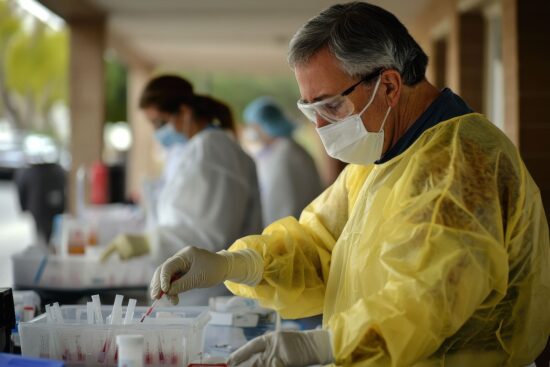The global public health landscape is a dynamic field, continuously shaped by emerging diseases, technological advancements, and shifting societal needs. At its core, public health aims to protect and improve the health of communities through disease prevention, health education, and policy development. Laboratory diagnostics, on the other hand, is the cornerstone of clinical and public health practice, providing the data necessary to detect, monitor, and respond to health threats. Genesis Reference Laboratories explains that the intersection of these two disciplines highlights a collaborative approach that is critical for addressing contemporary health challenges.
The Role of Laboratory Diagnostics in Public Health
Laboratory diagnostics provides the tools and techniques to identify pathogens, monitor disease outbreaks, and evaluate the effectiveness of interventions. From detecting the genetic material of viruses to analyzing blood samples for biomarkers, diagnostics enables healthcare professionals to make informed decisions that protect public health. Key roles of laboratory diagnostics include:
- Disease Surveillance
Accurate and timely laboratory testing is essential for disease surveillance. Diagnostic labs collect and analyze data on infectious diseases, such as influenza, COVID-19, and tuberculosis, enabling public health authorities to track trends, identify outbreaks, and implement control measures.
- Outbreak Response
During public health emergencies, such as the Ebola outbreak or the COVID-19 pandemic, diagnostic labs play a pivotal role in detecting cases, confirming diagnoses, and monitoring the spread of disease. Rapid diagnostic tests (RDTs) have revolutionized outbreak response by providing near-instant results, especially in resource-limited settings.
- Antimicrobial Resistance Monitoring
The rise of antimicrobial resistance (AMR) is a significant public health concern. Laboratories analyze samples to determine resistance patterns, guiding the development of treatment protocols and informing policy on antibiotic use.
Collaboration Between Public Health and Diagnostics
The synergy between public health initiatives and laboratory diagnostics is evident in numerous areas. This collaboration enhances disease prevention, ensures effective resource allocation, and improves health outcomes. Key aspects of this partnership include:
- Integrated Disease Management
Public health agencies rely on diagnostic data to design and implement disease management strategies. For example, during the COVID-19 pandemic, real-time data from diagnostic labs informed public health measures such as lockdowns, contact tracing, and vaccine distribution.
- Data Sharing and Analytics
Collaborative platforms for data sharing between laboratories and public health agencies enhance the accuracy and timeliness of health interventions. Advances in bioinformatics and big data analytics have enabled the integration of diagnostic data into epidemiological models, predicting disease spread and guiding policy decisions.
- Capacity Building
Collaboration fosters capacity building in resource-limited settings. Public health programs often partner with diagnostic labs to provide training, equipment, and infrastructure, improving the quality and accessibility of laboratory services.
- Public Health Research
Joint research initiatives between public health organizations and diagnostic labs drive innovation. Studies on emerging pathogens, and health disparities benefit from the combined expertise of these fields.
Challenges in the Collaborative Approach
While the intersection of public health and laboratory diagnostics offers numerous benefits, it also presents challenges that must be addressed to maximize its potential. These challenges include:
- Resource Limitations
Inadequate funding and infrastructure can hinder the capacity of diagnostic labs to support public health efforts. Resource-constrained regions often struggle with shortages of trained personnel, equipment, and reagents.
- Data Integration
The lack of standardized data formats and protocols complicates the integration of laboratory results into public health systems. Interoperable data systems are essential for seamless communication and collaboration.
- Workforce Development
The demand for skilled laboratory professionals often outpaces supply. Addressing this gap requires investment in education and training programs that equip individuals with the skills needed for diagnostic and public health work.
- Ethical and Privacy Concerns
The collection and sharing of diagnostic data raise ethical and privacy concerns. Ensuring that data is used responsibly and securely is critical for maintaining public trust.
Emerging Trends in Public Health Diagnostics
The future of public health and laboratory diagnostics is shaped by technological innovations and evolving health priorities. Key trends include:
- Point-of-Care Testing
Point-of-care (POC) testing brings diagnostic capabilities to the patient, reducing the time between testing and treatment. This approach is particularly valuable in remote and underserved areas.
- Molecular Diagnostics
Advances in molecular techniques, such as polymerase chain reaction (PCR) and next-generation sequencing (NGS), enable rapid and precise identification of pathogens. These methods are instrumental in detecting emerging diseases and understanding their genetic makeup.
- Artificial Intelligence and Machine Learning
AI and machine learning are transforming diagnostics by automating data analysis and improving predictive accuracy. These technologies support faster and more efficient outbreak detection and resource allocation.
- Global Health Initiatives
Collaborative global health initiatives, such as the Global Health Security Agenda (GHSA), emphasize the integration of diagnostics into public health frameworks to address global health threats.
The intersection of public health and laboratory diagnostics represents a collaborative approach that is essential for addressing modern health challenges. By leveraging the strengths of both fields, this partnership enhances disease prevention, improves outbreak response, and drives innovation in healthcare. While challenges remain, continued investment in technology, workforce development, and data integration will ensure that the collaboration between public health and laboratory diagnostics remains a cornerstone of global health efforts. Through this synergy, communities can better prepare for, respond to, and recover from health threats, fostering a safer and healthier world for all.
